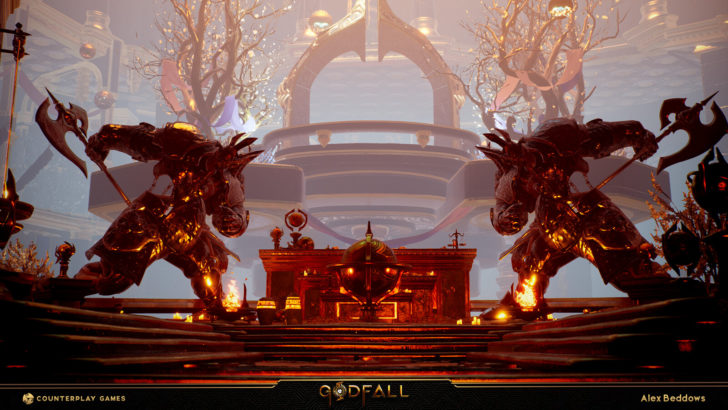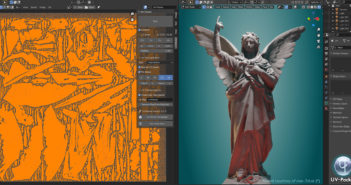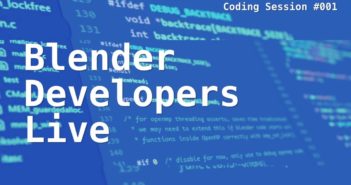
Interview with
Alex Beddows:
Sr. Environment Artist
This and more interviews can be found in Edge Loop Magazine
My name is Alex Beddows, I am a Senior Environment Artist at Counterplay Games, working fully remote out of Coventry in the UK. The role includes all aspects of environment art: creating assets, materials and figuring out pipelines to complete a level, while also handling the level art and applying these assets. Some things I have to consider when creating levels are compositions, lighting and performance.
How is Blender utilized in your pipeline?
Blender is pretty key to my pipeline, as any modelling package is to an environment artist. I use it mainly for two purposes on Godfall; A) For mapping trim sheets to modular pieces and tiles. I actually really like Blender for this as the non destructive workflow allows for very quick and clean iteration on the kit. B) Using the simulation tools to generate height maps based on simulated geo, which I can then take into Substance Designer to generate materials. Sometimes you take the material back into Blender and displace meshes based on the final material to keep asset cost down.
Do you use any add-ons for Blender?
I heavily rely on a free one, Machine Tools, which just helps my general flow and it has some really nice pie menus and has some cleaned up shortcuts. There are two amazing paid ones too, Mesh Machine and Decal Machine, but I haven't needed to use them really as they are heavily suited to hard surfaces.
Is Blender used throughout your game studio?
This conversation is interesting. The fact of the matter is most studios don't have too much of an issue with what modelling package you use. The only time you are forced to use a package is due to tools being built around a software which is quite common. Here we have Blender users, Max users and Maya users,. The conversation of ‘is Blender industry standard?’ should be dead in the water. The fact is there are things outside of the artist’s control that dictate the tools you need to use, however when it's open, you can comfortably use Blender.
What other programs do you use?
So I use quite a varied set of programs. As an environment artist you have so many sub-categories of skills to be aware of, we naturally have a broad set of tools that we use.
I use:
Blender
, Substance Designer,
Substance Painter,
UE4,
Houdini
, Mixer,
ZBrush,
Photoshop.
It is mostly about what can give me good results quickly, so not becoming attached to your tool is a good idea. I most commonly see people get attached to their modelling package which is not a great idea.
I learn this from people like Mathew O’Halloran who will use all the modelling packages interchangeably depending on the task at hand. Though I am not saying ‘go and learn all of them’. What I am saying is learning the principles of what you are doing so you can translate the skills between packages is a very good long term strategy.
Can you give an overview of the process from start to finish of Godfall - Air Realm Caves?
So our process for taking an environment to completion is pretty systematic. Firstly the environment artists are given A LOT of autonomy. We are able to come up with our own designs for how spaces look, and work closer with our Lighting Artists to get a cohesive vision.
Level Designers will block the space out and place key things such as combat spaces, boss fights and collectables.
From here we have two main stages.
Alpha Pass- This is us as Level Artists essentially exploring ideas. We have our block-out but we need to figure out exactly what this space is going to be, put the big strokes down with our macro shapes and show our intention going forward. We purposely don't detail too much so that we are able to receive feedback from our Art Director (Tim Simpson) as he will need to see the spaces as a whole see the spaces from a wider perspective. At this point you can spot inconsistencies or problems that need to be addressed for gameplay reasons.
If we detail a bunch, two things happen;
One, a lot of problems can hide in noisy details, or areas are left underdeveloped because so much time was spent dressing a certain area up past alpha.
Two, if for instance a big design changes, for example a boss encounter is moved to a new spot and you over detailed the level then it is both a pain in the a** to move all of that, and it is very damaging to your morale (even if it is your own fault as an artist).
Polish pass- This is essentially us as artists taking the green lit alpha pass and dressing it to a final ship-able product. Sometimes you have concepts, sometimes you don't but in the alpha pass you have explored a lot of your ideas so the polish pass really is going through the motions. You start dressing in a way that really grounds all the big props and structures in the world.
This means refining compositions. For example painting landscapes to be really detailed and beautiful, placing foliage and debris to make the space feel like a living world and also placing decals on meshes to make them feel unique to the area. Although this may sound like a lot, it is second nature to environment artists. The real head scratchers come in the alpha pass where we try to figure spaces out whereas in polish we know what we want its just a case of doing it.

How long do you work on an environment before it's ready for the game?
How long is a piece of string? Environments vary so much based on so many factors and, other department’s decisions and time scales impact an environment's time scale not just creating it. We have to take into account level design, narrative and high level art direction all of which can change and influence one another.
I could estimate a full blockout to final art pass to take between one to two months but this can vary. One example could be:
- Design wants to move a boss...
... which changes the narrative flow and locations need to change to match story beats ...
... which introduces new art direction issues that we need to solve.
You can see how these kinds of factors can really mess up a time scale in an environment, and to be crystal clear, this is normal.
This is game development. It requires trial and error to get to the best end product and your studio is a team. We all want a great product at the end so anticipate changes. This is actually a great hallmark of a competent dev, they can roll with changes and not let it impact their ability to create art.
What do you wish you would have known about being an environment artist before you started your career?
Just how big the field is. Early on I tried to do and be everything and the fact of the matter is you don't have to. We have specialist tech, lighting, material, asset and level artists, and granted this varies from studio to studio but if I had known and been okay with this earlier I could have focused my time and energy elsewhere.

What should someone practice if they want to get into creating environments for games?
Practice pipelines. I see so many artists spend 80% of their time on making and texturing one-to-one props. Environment art is so much more than that. Showcasing pipelines like trim sheets, modular assets and leveraging tileable materials is really important. Yes learn how to make one-to-one assets but understand that is like 30% of environment art, and more 1 to 1 assets get sent out to outsource for production so bear that in mind too.
What artists do you look to for inspiration?
This is a funny question which has changed a lot over the years. Early on I looked to influential figures within the industry. The likes of Ben Wilson, Tim Simpson and Daniel Thiger. These guys are both masterful artists in their domains but also do a lot for the wider industry in helping development and growth of artists.
But there came a mindset shift. I only see these guy’s highlight reel. I never see their development, struggles, mistakes or growth and therefore I have no way of quantifying anything. So yeah I look to them to see the cutting edge of what artists can do but for inspiration I look to my close circle of friends in the industry.
I spend everyday talking to these guys, seeing them tackle a project and go through the struggles, headaches and how we all make time to help each other. That's inspirational for me and, seeing the guys really apply themselves while maintaining a social life, a career and still hungering to climb and develop as artists. ALL of my inspiration for producing great art and developing comes from being around them.






